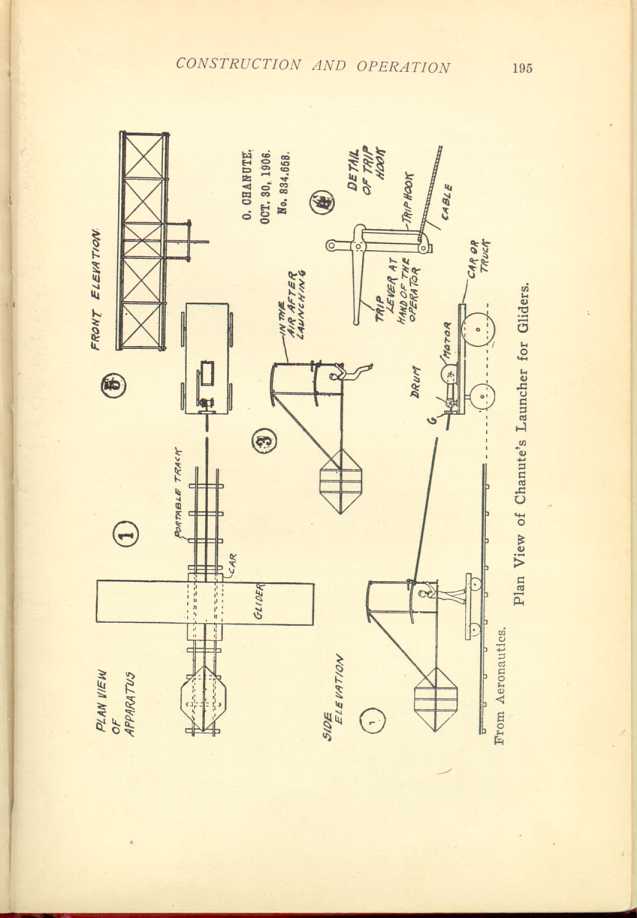21. CHAPTER XXI.
FLYING MACHINES VS. BALLOONS.
While wonderful success has attended the development of the dirigible (steerable) balloon the most ardent advocates of this form of aerial navigation admit that it has serious drawbacks. Some of these may be described as follows:
Expense and Other Items.
Great Initial Expense.—The modern dirigible balloon costs a fortune. The Zeppelin, for instance, costs more than $100,000 (these are official figures).
Expense of Inflation.—Gas evaporates rapidly, and a balloon must be re-inflated, or partially re-inflated, every time it is used. The Zeppelin holds 460,000 cubic feet of gas which, even at $1 per thousand, would cost $460.
Difficulty of Obtaining Gas.—If a balloon suddenly becomes deflated, by accident or atmospheric conditions, far from a source of gas supply, it is practically worthless. Gas must be piped to it, or the balloon carted to the gas house—an expensive proceeding in either event.
Lack of Speed and Control.
Lack of Speed.—Under the most favorable conditions the maximum speed of a balloon is 30 miles an hour. Its great bulk makes the high speed attained by flying machines impossible.
Difficulty of Control.—While the modern dirigible balloon
The Element of Danger.—Numerous balloons have been destroyed by lightning and similar causes. One of the largest of the Zeppelins was thus lost at Stuttgart in 1908.
Some Balloon Performances.
It is only a matter of fairness to state that, under favorable conditions, some very creditable records have been made with modern balloons, viz:
November 23d, 1907, the French dirigible Patrie, travelled 187 miles in 6 hours and 45 minutes against a light wind. This was a little over 28 miles an hour.
The Clement-Bayard, another French machine, sold to the Russian government, made a trip of 125 miles at a rate of 27 miles an hour.
Zeppelin No. 3, carrying eight passengers, and having a total lifting capacity of 5,500 pounds of ballast in addition to passengers, weight of equipment, etc., was tested in October, 1906, and made 67 miles in 2 hours and 17 minutes, about 30 miles an hour.
These are the best balloon trips on record, and show forcefully the limitations of speed, the greatest being not over 30 miles an hour.
Speed of Flying Machines.
Opposed to the balloon performances we have flying machine trips (of authentic records) as follows:
Bleriot—monoplane—in 1908—52 miles an hour.
Delagrange—June 22, 1908—10 1/2 miles in 16 minutes, approximately 42 miles an hour.
Wrights—October, 1905—the machine was then in its infancy—24 miles in 38 minutes, approximately 44 miles an hour. On December 31, 1908, the Wrights made 77 miles in 2 hours and 20 minutes.
Lambert, a pupil of the Wrights, and using a Wright biplane, on October 18, 1909, covered 29.82 miles in 49 minutes and 39 seconds, being at the rate of 36 miles an hour. This flight was made at a height of 1,312 feet.
Latham—October 21, 1909—made a short flight, about 11 minutes, in the teeth of a 40 mile gale, at Blackpool, Eng. He used an Antoniette monoplane, and the official report says: "This exhibition of nerve, daring and ability is unparalled in the history of aviation."
Farman—October 20, 1909—was in the air for 1 hour, 32 min., 16 seconds, travelling 47 miles, 1,184 yards, a duration record for England.
Paulhan—January 18, 1901—47 1/2 miles at the rate of 45 miles an hour, maintaining an altitude of from 1,000 to 2,000 feet.
Expense of Producing Gas.
Gas is indispensable in the operation of dirigible balloons, and gas is expensive. Besides this it is not always possible to obtain it in sufficient quantities even in large cities, as the supply on hand is generally needed for regular customers. Such as can be had is either water or coal gas, neither of which is as efficient in lifting power as hydrogen.
Hydrogen is the lightest and consequently the most buoyant of all known gases. It is secured commercially by treating zinc or iron with dilute sulphuric or hydrochloric acid. The average cost may be safely placed at $10 per 1,000 feet so that, to inflate a balloon of the size of the Zeppelin, holding 460,000 cubic feet, would cost $4,600.
Proportions of Materials Required.
In making hydrogen gas it is customary to allow 20 per cent for loss between the generation and the introduction of the gas into the balloon. Thus, while the
In Time of Emergency.
These figures are appalling, and under ordinary conditions would be prohibitive, but there are times when the balloon operator, unable to obtain water or coal gas, must foot the bills. In military maneuvers, where the field of operation is fixed, it is possible to furnish supplies of hydrogen gas in portable cylinders, but on long trips where sudden leakage or other cause makes descent in an unexpected spot unavoidable, it becomes a question of making your own hydrogen gas or deserting the balloon. And when this occurs the balloonist is up against another serious proposition—can he find the necessary zinc or iron? Can he get the acid?
Balloons for Commercial Use.
Despite all this the balloon has its uses. If there is to be such a thing as aerial navigation in a commercial way—the carrying of freight and passengers—it will come through the employment of such monster balloons as Count Zeppelin is building. But even then the carrying capacity must of necessity be limited. The latest Zeppelin creation, a monster in size, is 450 feet long, and 42 1/2 feet in diameter. The dimensions are such as to make all other balloons look like pigmies; even many ocean-going steamers are much smaller, and yet its passenger
